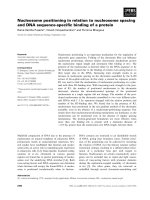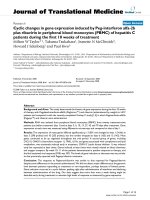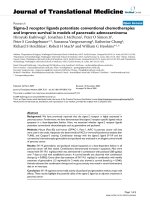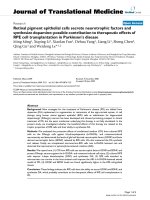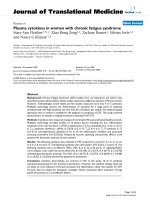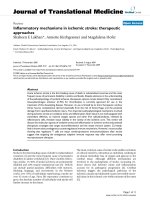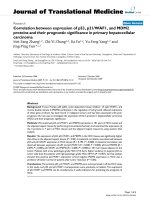Báo cáo hóa học: " Muscle fatigue in relation to forearm pain and tenderness among professional computer users" docx
Bạn đang xem bản rút gọn của tài liệu. Xem và tải ngay bản đầy đủ của tài liệu tại đây (320.29 KB, 7 trang )
BioMed Central
Page 1 of 7
(page number not for citation purposes)
Journal of Occupational Medicine
and Toxicology
Open Access
Research
Muscle fatigue in relation to forearm pain and tenderness among
professional computer users
Gert F Thomsen
1,2
, Pete W Johnson
3
, Susanne W Svendsen
1
, AnnIKryger
4
and Jens Peter E Bonde*
1
Address:
1
Department of Occupational Medicine, Aarhus University Hospital, Noerrebrogade 44, building 2 C, 8000 Århus, Denmark,
2
Department of Occupational Medicine, Ribe County Hospital, Oestergade 80, 6700 Esbjerg, Denmark,
3
Department of Environmental and
Occupational Sciences, School of Public Health, Seattle, USA and
4
Department of Occupational and Environmental Medicine, Copenhagen
University Hospital, Bispebjerg Bakke 23, 2400 Copenhagen NV, Denmark
Email: Gert F Thomsen - ; Pete W Johnson - ; Susanne W Svendsen - ;
Ann I Kryger - ; Jens Peter E Bonde* -
* Corresponding author
Abstract
Background: To examine the hypothesis that forearm pain with palpation tenderness in
computer users is associated with increased extensor muscle fatigue.
Methods: Eighteen persons with pain and moderate to severe palpation tenderness in the
extensor muscle group of the right forearm and twenty gender and age matched referents without
such complaints were enrolled from the Danish NUDATA study of neck and upper extremity
disorders among technical assistants and machine technicians. Fatigue of the right forearm extensor
muscles was assessed by muscle twitch forces in response to low frequency (2 Hz) percutaneous
electrical stimulation. Twitch forces were measured before, immediately after and 15 minutes into
recovery of an extensor isometric wrist extension for ten minutes at 15 % Maximal Voluntary
Contraction (MVC).
Results: The average MVC wrist extension force and baseline stimulated twitch forces were equal
in the case and the referent group. After the fatiguing contraction, a decrease in muscle average
twitch force was seen in both groups, but the decrease was largest in the referent group: 27% (95%
CI 17–37) versus 9% (95% CI -2 to 20). This difference in twitch force response was not explained
by differences in the MVC or body mass index.
Conclusion: Computer users with forearm pain and moderate to severe palpation tenderness had
diminished forearm extensor muscle fatigue response. Additional studies are necessary to
determine whether this result reflects an adaptive response to exposure without any
pathophysiological significance, or represents a part of a causal pathway leading to pain.
Introduction
Intensive use of mouse and keyboard among professional
computer users has been identified as a risk factor for pain
in various regions of the upper extremity including the
forearm [1-3]. The mechanism and pathophysiology of
the pain response are not well understood [4]. In most
Published: 8 December 2007
Journal of Occupational Medicine and Toxicology 2007, 2:17 doi:10.1186/1745-6673-2-17
Received: 20 August 2007
Accepted: 8 December 2007
This article is available from: />© 2007 Thomsen et al; licensee BioMed Central Ltd.
This is an Open Access article distributed under the terms of the Creative Commons Attribution License ( />),
which permits unrestricted use, distribution, and reproduction in any medium, provided the original work is properly cited.
Journal of Occupational Medicine and Toxicology 2007, 2:17 />Page 2 of 7
(page number not for citation purposes)
studies pain complaints are poorly associated with com-
monly accepted criteria for specific clinical diagnoses.
Muscle fatigue can be defined as an exercise induced tran-
sient decrease in the force generating capacity of the mus-
cle [5]. While electromyography (EMG) can be used to
measure muscle fatigue in moderate to high force work
[6,6], it is rather insensitive to fatigue developed during
the performance of low force occupational activities such
as the use of mouse and keyboard [7,8]. The ratio of force
output from low and high frequency (e.g. 20 Hz and 100
Hz) electrical stimulation has been used as a measure of
muscle fatigue [9-11]. In some persons high frequency
stimulation is very unpleasant, which makes this method
less suitable for epidemiological studies and which may
introduce selection problems. In 1998 Johnson demon-
strated that the a muscle's force (twitch) response follow-
ing very low frequency (2 Hz) electrical stimulation of a
forearm flexor muscle was a reliable method to measure
muscle fatigue [12,13]. Significant but transient levels of
muscle fatigue were observed in computer users who
applied average forces between 0.7 and 6.5% of the max-
imal voluntary contraction (MVC) for 3 to 4 hours [12].
However, EMG measurements indicate higher load of the
forearm extensor muscle groups compared to the flexor
muscle groups during use of the mouse and keyboard [14-
17]. Therefore we adapted the 2 Hz stimulation technique
used by Johnson and others [13,18] to measure muscle
fatigue of the forearm extensor muscles.
The purpose of the study was to investigate the hypothesis
that computer users with forearm pain have a higher level
of extensor muscle fatigue than computer users without
forearm pain [17]. The study is part of the Danish nation-
wide NUDATA study of neck and upper extremity disor-
ders among technical assistants and machine technicians
[2].
Subjects and methods
Selection of participants and assessment of forearm pain
and tenderness
Computer users with forearm pain (cases) and without
forearm pain (referents) were recruited among respond-
ents in the NUDATA study. In January through June 2000
6,943 participants of 9,480 (73%) technical assistants and
machine technicians completed a baseline questionnaire
on job tasks, lifestyle and pain in the upper extremities
including the forearms [2]. Forearm pain within the past
seven days was assessed on a nominal scale with eight
pain categories (no pain, very little pain, little pain, little
to moderate pain, moderate pain, moderate to severe
pain, severe pain, and very severe pain). Subjects reporting
at least moderate pain in one or both forearms during the
past 7 days were defined as symptom cases in the
NUDATA study and were offered a clinical examination
that took place within 14 days of receipt of the question-
naire data. Palpation tenderness in the proximal lateral
aspect of the forearm extensor muscle group was assessed
using a digital pressure of approximately 4 kg perpendic-
ular to the surface. The response was scored on a 0–3 scale
(0, none; 1, mild without withdrawal; 2, moderate with
withdrawal; 3, severe with jump sign).
Eligibility criteria
Assistants and technicians with forearm pain (cases)
Among participants who reported at least moderate pain
in the right forearm during the past 7 seven days and at the
clinical examination showed moderate or severe palpa-
tion tenderness, we invited the first 24 consecutive cases
in the Aarhus region to take part in this study. Twenty per-
sons accepted, but two declined participation after enrol-
ment. Specific job tasks as work at video display terminals
were not requested but due to the sampling frame all par-
ticipants used computers to some degree in their daily
work.
Assistants and technicians without forearm pain (referents)
For each accepting case we enrolled concomitantly from
the same cohort and geographic area a participant of same
sex and age (within a 5 year interval) without any self-
reported pain in the upper extremities during the last 12
months. The referents that matched the two case subjects
who withdrew after enrolment were kept in the study.
None of the referents had become cases during the time
elapsed from filling in the questionnaire and enrolment
into this study.
Exclusion criteria
Assistants and technicians with a history of surgery involv-
ing the right extremity, trauma sequelae, epicondylitis,
carpal tunnel syndrome and arthritis were not eligible for
the study. Furthermore, workers with abnormal range of
movement in the right shoulder, elbow, wrist or fingers or
with signs of acute inflammation (swelling, rubor and
increased skin temperature) in these regions were
excluded.
All examinations were performed at the Department of
Occupational Medicine αt Aarhus University Hospital.
Cases and controls were intermingled across time and the
examiner was blinded to case or control status. The time
schedule for the tests for one subject can be seen in Figure
1. The regional ethical committee approved the study and
all subjects signed an informed consent prior to enrol-
ment into the present study.
MVC-measurements
The maximal voluntary wrist extension forces were meas-
ured using a force measurement apparatus with a standard
voltmeter reading the amplifier output voltage. The meas-
Journal of Occupational Medicine and Toxicology 2007, 2:17 />Page 3 of 7
(page number not for citation purposes)
urements were calibrated using laboratory grade weights.
Each subject performed three maximum exertions while
encouraged to extend the wrist and fingers as forceful as
possible. The posture of the forearm is indicated in Figure
2. Participants were allowed to relax for a couple of min-
utes between each exertion. The highest recorded of the
three force readings defined the subject's MVC.
Twitch force measurements
Muscle twitches were evoked using a custom built timer
and a Digitimer DS7A Constant Current Electrical Stimu-
lation Unit. Figure 2 shows the experimental set-up. The
right forearm extensor muscles were stimulated using a 12
mm (active) Stimtrode Ag/AgCl electrode, which was
placed on the proximal lateral aspect of the forearm one
third of the distance between the elbow and wrist. The
electrode was placed over the muscle belly that could be
felt/palpitated when the third finger was extended. A 20
mm (passive) electrode was placed just anterior-medial to
caput radii at the elbow. The muscle was stimulated with
100 microsecond square pulses at a frequency of 2 Hz.
The twitch forces were measured with an Omega LC105
force transducer and an Omega DMD 465 amplifier
(Omega Engineering Inc.; Stamford, CT USA) placed as
indicated in Figure 2. In setting up the experimental pro-
cedures it proved more convenient to measure extensor
muscle twitch force at the metacarpophalangeal (MCP)
joint rather than a position distal to this location. Data
was collected with an IBM PC instrumented with a data
acquisition card (model AT-MIO-16E; National Instru-
Placement of electrodes and force transducer in a study of right forearm extensor muscle twitch forcesFigure 2
Placement of electrodes and force transducer in a study of
right forearm extensor muscle twitch forces. A vertical plate
to stabilize the distal forearm and wrist region sideways is
not shown in order not to hide the transducer.
Experimental design and protocol for measurements of right forearm extensor muscle twitch forces in 38 whitecollar workers with and without forearm painFigure 1
Experimental design and protocol for measurements of right forearm extensor muscle twitch forces in 38 whitecollar workers
with and without forearm pain.
Journal of Occupational Medicine and Toxicology 2007, 2:17 />Page 4 of 7
(page number not for citation purposes)
ments; Austin, TX USA) running Labview Software (ver-
sion 3.0; National Instruments; Austin, TX USA). The
sampling frequency was 1000 Hz.
Calibration of the stimulation current
After the hand had been placed in the apparatus (Figure
2), the current was gradually increased up to or above 40
mA. In a pilot study, this current level was tolerable to
most persons and produced contractions with sufficient
force (> 1.0 N) to ensure reliable measurements. Nine per-
sons did not tolerate 40 mA, but currents ranging between
32.5 and 37.5 mA produced reproducible twitch
responses. In other seven persons 40 mA produced con-
tractions that were insufficient to ensure reliable force
measurements. In these subjects the current was increased
to 42 – 50 mA. For each individual, the established cur-
rent level was kept through the rest of the study. To accus-
tom the subject to the procedures, a full pilot
measurement was performed 30 minutes prior to the
experiment.
Experimental procedure
In the experiment the subject performed an exercise con-
sisting of a static wrist extension at 15% of MVC for 5 min-
utes, 30 seconds break and another 5 minutes 15% MVC
wrist extension. The duration of the exercises was set
according to earlier experience [19,20]. The force was
measured in the same way as at the MVC-manoeuvre. The
subject could see the force reading and was urged by the
researcher to keep the force level. Before (baseline),
immediately after the exercise (post-exercise), and 15
minutes after exercise (recovery) twitch measurements
were collected.
It is well known that the muscle force increases during the
initial phase of a muscle contraction – whether stimulated
or voluntary [21,22]. At each measurement (baseline,
post-exercise, and recovery), the subject's muscle was
therefore first conditioned with 90 seconds continuous 2
Hz electrical stimulation in order to reach the plateau of
steady state twitch force [12,13,18]. Immediately after the
conditioning, muscle twitch forces were measured during
five trains of approximately 30 twitch stimulations.
Between each of the five trains, subjects removed and
repositioned their hands in the measurement apparatus in
order to minimize minor effects that hand position might
have on recorded twitch force (Figure 3). The hand repo-
sitioning between trains typically took less than five sec-
onds.
Statistical analyses
For the five trains collected from each subject at each time
period, the between-5 train coefficient of variation (CV)
was computed by dividing the train standard deviation by
the mean [23]. Average values were then computed across
times for the cases and referents, respectively.
To allow comparisons of twitch measurements between
subjects, twitch force data were standardized with respect
to the baseline measurements performed before the vol-
untary wrist extension exercise. A repeated measures anal-
ysis of variance [SAS version 8.02 Proc Mixed random
(SAS Institute, Cary, NC)] was used to determine whether
the twitch forces differed after the exercise in comparison
with baseline levels among cases and referents and
whether the changes relative to baseline values differed
between the two groups. In all analyses, the dependent
variable was the standardized twitch force of the single
contractions and independent variables included case sta-
tus (case/referent) and time (baseline, post-exercise,
recovery). In additional analyses the possible confound-
ing effects of a number of extraneous factors were evalu-
Time-force record (screen printout) from a single measurement consisting of 90 seconds of conditioning followed by five trains of approximately 30 twitch stimulations separated by removal and repositioning of the handFigure 3
Time-force record (screen printout) from a single measurement consisting of 90 seconds of conditioning followed by five trains
of approximately 30 twitch stimulations separated by removal and repositioning of the hand.
Journal of Occupational Medicine and Toxicology 2007, 2:17 />Page 5 of 7
(page number not for citation purposes)
ated in multiple regression analyses. These factors
included gender, age (> = 40 years: yes/no), current smok-
ing (yes/no), body mass index (BMI) (> 27 kg/m
2
: yes/no)
and physical activity in leisure time (three levels).
Results
The characteristics of the study population are outlined in
Table 1. The majority of participants were women (over
80%) and the average age was 43.4 years (range 25–55
years). The distributions of lifestyle factors were similar in
the case and the reference group but the cases reported
slightly more working hours, computer work and mouse
use. The average force recorded during maximal voluntary
extension of the wrist was at the same level among cases
and referents. The baseline stimulated twitch forces aver-
aged 2.29 (SD 1.58 N) showing no difference between the
case group and the reference group. The coefficients of
variation in the three series of measurements are dis-
played in Table 2. The reliability of the twitch force meas-
urement was very high – on average, the coefficient of
variation between 5 trains was 1.2 %.
Among the referents we observed extensor muscle fatigue
following the 10 minutes exercise at 15% of MVC as indi-
cated by a 17 % decline in twitch force compared to base-
line levels. The fatigue developed further during the first
15 minutes of the recovery phase (Table 3).
Among the cases we did not observe any reduction in
muscle force immediately after the exercise but a slight
decrease in twitch force during the recovery period. Cur-
rent smoking, age and MVC were not related to muscle
fatigue but higher BMI was associated with a higher degree
of fatigue (p = 0.01). Inclusion of these covariates into the
models did not change the displayed effects of exercise on
twitch forces.
Discussion
In this study, computer users with pain and moderate to
severe palpation tenderness in the forearm experienced
less forearm extensor muscle fatigue after an exercise pro-
tocol than a healthy referent group. This finding is con-
trary to our a- priory hypothesis stating that pain and
tenderness of the forearm would be associated with
increased muscle fatigue.
The observed muscular fatigue response among the refer-
ents is consistent with earlier findings. Blangsted observed
muscular fatigue as measured with mechanomyography
and electromyography in the extensor carpi radialis mus-
cle 30 minutes following a 10 minutes 10% MVC wrist
extension [19]. In Johnson's experiments a 10% reduction
in flexor muscle twitch force was observed immediately
after 10 minutes static contractions at 15% of MVC, which
increased to 20% reduction after 30 minutes [12]. Follow-
Table 1: Characteristics of study groups
Characteristics Cases Referents
Gender, n (%)
Female 15 (83%) 17 (85%)
Male 3 (17%) 3 (15%)
Age, years, mean (min-max) 43.0 (25.5–53.4) 43.8 (28.4–55.2)
Body mass index, kg/m
2
, mean (min-max) 24.6 (30.7–19.3) 23.6 (34.6–19.5)
Smoking, n (%)
Never smoking 8 (44%) 12 (60%)
Ex-smoker 7 (39%) 4 (20%)
Current smoker 3 (17%) 4 (20%)
Leisure time physical activity, n (%)
Less than 2 hours/week 5 (28%) 4 (20%)
2–4 hours/week 8 (44%) 10 (50%)
More than 4 hours/week 5 (28%) 6 (20%)
Working conditions
1
, mean (SD)
Work hours/week 37.0 (5.0) 35.5 (3.3)
Computer use, hours/week 28.6 (5.7) 23.9 (9.3)
Mouse use, hours/week 22.0 (11.1) 18.9 (12.8)
Wrist extension force, mean (SD)
Maximal voluntary contraction (Newton) 107.9 (51.5) 110.1 (32.6)
Stimulation current (mA), mean (SD) 40.1 (4.9) 39.6 (3.1)
Twitch force at baseline (Newton), mean (SD) 2.32 (1.63) 2.27 (1.56)
1
Self reported, questionnaire
Journal of Occupational Medicine and Toxicology 2007, 2:17 />Page 6 of 7
(page number not for citation purposes)
ing a similar provocation of the forearm extensor muscles
in our referent group we observed 17% reduction in
twitch force immediately after the contraction, which
increased to 27% after 15 minutes. In contrast, in our
cases we saw virtually no change in twitch forces immedi-
ately after the contraction and only a 9% decrease 15 min-
utes into the recovery period. Referents and cases were
investigated in random order and thus a change in meas-
urement conditions or the experimental set-up across the
study period is not likely to explain our findings. Moreo-
ver, the very low coefficient of variation of less than 5% in
the majority of measurements indicates that our methods
were reliable.
A diminished fatigue response among the persons with
forearm pain might result if the pain caused the subjects
to produce reduced force at the maximal voluntary con-
traction and subsequently cause reduced power at the
exercise before the twitch measurements. However, the
findings are not the result of a lower force output in per-
sons with forearm pain since the absolute force during
stimulated contractions, the contraction force during exer-
cise and the maximum voluntary contractions were at the
same level in the two groups.
Cases and referents were recruited among members of the
same trade union and were therefore expected to be
socially and economically rather homogeneous. Care was
taken to ensure equal gender and age distributions in the
two samples and cases and referents were similar with
respect to a number of physical and lifestyle characteris-
tics. A higher BMI was associated with increased fatigue
but inclusion of this variable as well as leisure time phys-
ical activity and current tobacco smoking did not change
the observed associations between study group and degree
of fatigue. Nor was the level of statistical significance
affected. One to five months had past from the assign-
ment to the case and referent group until the measure-
ments were made. However, on the day of the experiment
the clinical examination assured that the referents had not
developed any muscle tenderness. Any bias due to the
cases becoming non-cases would lead to an underestima-
tion of the true difference between the groups.
Accordingly, we do not believe that the findings can be
explained by errors in the measurement technique or
biased statistical comparisons but obviously there is a
need to corroborate or refute the findings in independent
studies. Assuming that the findings reflect genuine biolog-
ical differences in muscle function among subjects with
and without forearm pain we need new hypotheses to
understand the results. Due to the cross-sectional study
design we cannot infer whether the diminished fatigue
response precedes the development of pain and maybe
makes the muscle more vulnerable to exposure, or
whether it is a correlate or consequence of pain.
It has been hypothesized that the patophysiology of upper
extremity muscle disorders including forearm pain in
computer users are caused by disorders of muscle cells or
limitations of the local circulation [24-26]. The Cindarella
hypothesis proposes that the development of chronic
muscular pain is due to an overuse of fibers belonging to
low-threshold motor units. It has in a study been demon-
strated, indeed, that there are motor units that are contin-
uously active under a 25 minutes static low-level excertion
of the extensor digitorum communis muscle while the
majority of motor units were only partially active over
Table 3: Average standardised forearm extensor muscle twitch forces among subjects with and without forearm pain and tenderness
measured at baseline, after 10 minutes exertion at 15% MCV, and 15 minutes into recovery.
Cases n = 18 Referents n = 20
Mean 95% CI Mean 95% CI P-value
1
Baseline 1.00 0.99–1.01 1.00 0.99–1.01 0.937
Post exercise 1.01 0.89–1.12 0.83 0.72–0.94 0.032
Recovery 0.91 0.80–1.02 0.73 0.63–0.83 0.017
All analyses were adjusted for the train number (1–5) and multiple measurements (30 in each train).
1
Test for difference of mean values in cases compared to referents.
Table 2: Average and range of the between-5 train twitch force coefficient of variations collected at each time period and grouped by
cases and referents.
Measurement time period Cases [n = 18] Coefficient of Variation,
%, Mean (min-max)
Referents [n = 20] Coefficient of
Variation, % Mean (min-max)
Baseline 1.6 (0.1–13.4) 1.9 (0.2 – 14.7)
Post exercise 1.0 (0.1 – 3.9) 1.2 (0.1 – 8.4)
Recovery 0.5 (0.0 – 2.1) 1.0 (0.1 – 5.6)
Publish with BioMed Central and every
scientist can read your work free of charge
"BioMed Central will be the most significant development for
disseminating the results of biomedical research in our lifetime."
Sir Paul Nurse, Cancer Research UK
Your research papers will be:
available free of charge to the entire biomedical community
peer reviewed and published immediately upon acceptance
cited in PubMed and archived on PubMed Central
yours — you keep the copyright
Submit your manuscript here:
/>BioMedcentral
Journal of Occupational Medicine and Toxicology 2007, 2:17 />Page 7 of 7
(page number not for citation purposes)
time [25]. Although speculative, it can be hypothesized
that forearm pain develop more frequent in workers with
a larger proportion of Cindarella fibers and if such fibers
are less likely to be fatigued by exercise this could explain
the limited decline in forearm muscle twitch among cases
in out study. If so, we would expect to observe the same
diminished fatigue pattern in the contra lateral forearm
without pain. Unfortunately this was not measured in this
study.
Conclusion
Computer users with moderate to severe forearm pain had
a diminished forearm extensor muscle fatigue response. It
cannot be inferred from this study whether the abnormal
fatigue pattern is a result of the pain or is part of the causal
mechanisms leading to pain. The findings need to be cor-
roborated and further explored in additional studies.
Competing interests
The author(s) declare that they have no competing inter-
ests.
Authors' contributions
SWS and JPB conceived the study. GT and PWJ designed
the experimental set-up and performed all measurements
and tests. GT and JPB analyzed the data and drafted the
manuscript. All contributed to revisions and approved the
final version of the paper.
Acknowledgements
The study was supported by the Danish Medical Research Council (grant
number: 9801292) and the National Work Environment Authority (grant
number 20000010486). Århus University Hospital provided equipment to
carry out twitch force measurements.
References
1. Gerr F, Marcus M, Ensor C, Kleinbaum D, Cohen S, Edwards A, Gen-
try E, Ortiz DJ, Monteilh C: A prospective study of computer
users: I. Study design and incidence of musculoskeletal
symptoms and disorders. Am J Ind Med 2002, 41:221-235.
2. Kryger AI, Andersen JH, Lassen CF, Brandt LP, Vilstrup I, Overgaard
E, Thomsen JF, Mikkelsen S: Does computer use pose an occupa-
tional hazard for forearm pain; from the NUDATA study.
Occup Environ Med 2003, 60:e14.
3. Lassen CF, Mikkelsen S, Kryger AI, Brandt LP, Overgaard E, Thomsen
JF, Vilstrup I, Andersen JH: Elbow and wrist/hand symptoms
among 6,943 computer operators: a 1-year follow-up study
(the NUDATA study). Am J Ind Med 2004, 46:521-533.
4. Sjogaard G, Lundberg U, Kadefors R: The role of muscle activity
and mental load in the development of pain and degenera-
tive processes at the muscle cell level during computer
work. Eur J Appl Physiol 2000, 83:99-105.
5. Vollestad NK: Measurement of human muscle fatigue. J Neuro-
sci Methods 1997, 74:219-227.
6. Stulen FB, De Luca CJ: Muscle fatigue monitor: a noninvasive
device for observing localized muscular fatigue. IEEE Trans
Biomed Eng 1982, 29:760-768.
7. Christensen H: Muscle activity and fatigue in the shoulder
muscles of assembly-plant employees. Scand J Work Environ
Health 1986, 12:582-587.
8. Oberg T, Karsznia A, Sandsjo L, Kadefors R: Work load, fatigue,
and pause patterns in clinical dental hygiene. J Dent Hyg 1995,
69:223-229.
9. Edwards RH, Hill DK, Jones DA, Merton PA: Fatigue of long dura-
tion in human skeletal muscle after exercise. J Physiol 1977,
272:769-778.
10. Bystrom S, Kilbom A: Electrical stimulation of human forearm
extensor muscles as an indicator of handgrip fatigue and
recovery. Eur J Appl Physiol Occup Physiol 1991, 62:363-368.
11. Dennerlein JT, Meeker JD: Occupational injuries among Boston
bicycle messengers. Am J Ind Med 2002, 42:519-525.
12. Johnson PW: The Development, Chariacterization and Implementation of
a Technique to Measure Muscle Fatigue During Computer Use University
of California; 1998.
13. Adamo DE, Martin BJ, Johnson PW: Vibration-induced muscle
fatigue, a possible contribution to musculoskeletal injury.
Eur J Appl Physiol 2002, 88:134-140.
14. Laursen B, Jensen BR, Ratkevicius A: Performance and muscle
activity during computer mouse tasks in young and elderly
adults. Eur J Appl Physiol 2001, 84:329-336.
15. Simoneau GG, Marklin RW, Berman JE: Effect of computer key-
board slope on wrist position and forearm electromyogra-
phy of typists without musculoskeletal disorders. Phys Ther
2003, 83:816-830.
16. Waersted M, Westgaard RH: Attention-related muscle activity
in different body regions during VDU work with minimal
physical activity. Ergonomics 1996, 39:661-676.
17. Visser B, De Looze M, De Graaff M, Van Dieen J: Effects of preci-
sion demands and mental pressure on muscle activation and
hand forces in computer mouse tasks. Ergonomics 2004,
47:202-217.
18. Murthy G, Kahan NJ, Hargens AR, Rempel DM: Forearm muscle
oxygenation decreases with low levels of voluntary contrac-
tion. J Orthop Res 1997, 15:507-511.
19. Blangsted AK, Sjogaard G, Madeleine P, Olsen HB, Sogaard K: Volun-
tary low-force contraction elicits prolonged low-frequency
fatigue and changes in surface electromyography and mech-
anomyography. J Electromyogr Kinesiol 2005, 15:138-148.
20. Johnson PW, Hagberg M, Hjelm EW, Rempel D: Measuring and
characterizing force exposures during computer mouse use.
Scand J Work Environ Health 2000, 26:398-405.
21. Alway SE, Hughson RL, Green HJ, Patla AE, Frank JS: Twitch poten-
tiation after fatiguing exercise in man. Eur J Appl Physiol Occup
Physiol 1987, 56:461-466.
22. Vandervoort AA, Quinlan J, McComas AJ: Twitch potentiation
after voluntary contraction. Exp Neurol 1983, 81:141-152.
23. Armitage P, Berry G: Statistical Methods in Medical Research Blackwell
Scientific Publications; 1987.
24. Visser B, van Dieen JH: Pathophysiology of upper extremity
muscle disorders. J Electromyogr Kinesiol 2006, 16:1-16.
25. Forsman M, Taoda K, Thorn S, Zhang Q: Motor-unit recruitment
during long-term isometric and wrist motion contractions: a
study concerning muscular pain development in computer
operators. International Journal of Industrial Ergonomics 2002,
30:237-250.
26. Hostens I, Ramon H: Assessment of muscle fatigue in low level
monotonous task performance during car driving. J Electromy-
ogr Kinesiol 2005, 15:266-274.

